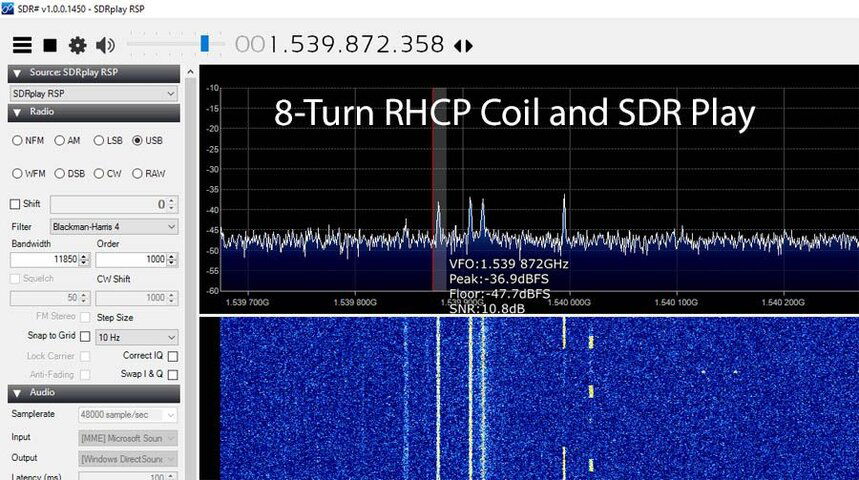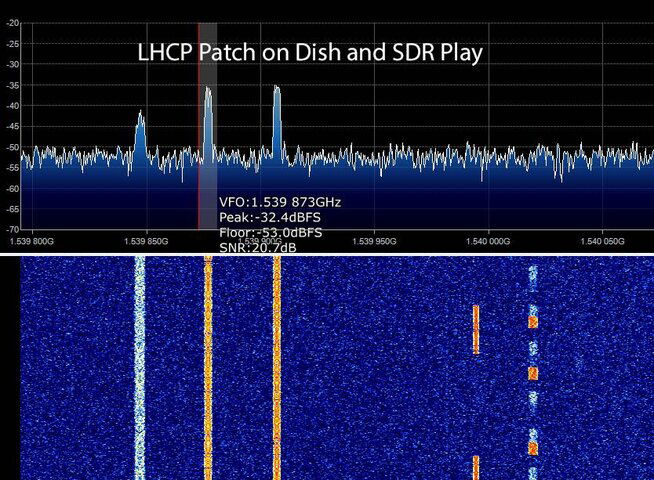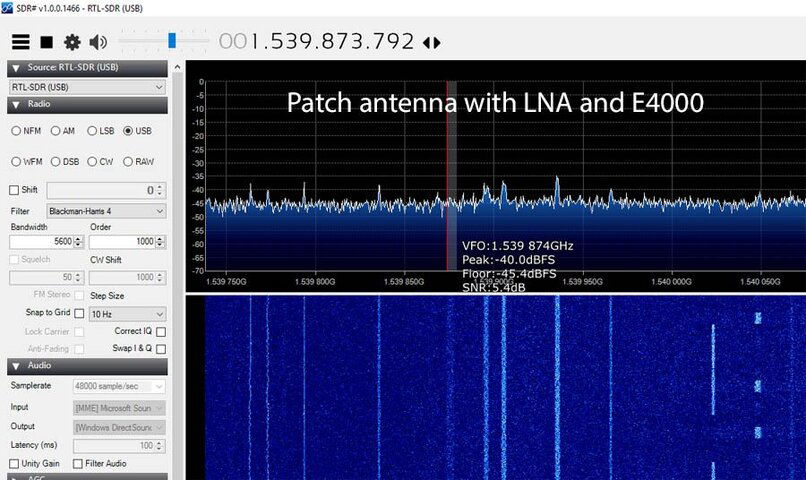I have built and modified some L-Band antennas over the past couple of weeks and thought it might be good to start a thread for sharing various L-Band antenna design projects and their performance.
Currently, L-Band is used for Outernet, Aviation, Maritime, FAX, paging, vessel tracking and miscellaneous other services. The frequency range is around 1.5 GHz for receiving and 1.6 GHz for transmitting. It uses RHCP (right hand circular polarity). But when an RHCP signal reflects off a surface it becomes LHCP.
Below are two of the antennas I made and my modified patch antenna:

3 Turn LHCP coil on Birdview

8 turn RHCP coil

Modified patch antenna showing LHCP feed added (left side of photo). Stock RHCP feed on right .

The patch at the Birdview's focal point and the coax connected to the LHCP feed point.
First I made an 8-turn RHCP helical coil. I used bare 14 gauge copper wire wound around a 2" ABS pipe with a round ground plane made out of sheet metal. I just used clear tape to hold the pipe in place and the wire on the tube. (If I had planned on using it long term I would have done it differently). I mounted an F-Connector on the sheet metal for easy connection to a coax cable. I got an SNR of 10.8 dB on the Outernet frequency using my SDRPlay.
Next, I made a 3-turn LHCP helical coil for use with a satellite dish. I got an SNR of 20.7 dB for Outernet!
After that, I replaced the coil with an Outernet Air Gap Patch antenna that I purchased on Amazon. As purchased, it is RHCP and I figured there would be some loss since it was the wrong polarity for use with a dish. The SNR was 11.8 dB.
So then I modified the Patch antenna to receive LHCP by drilling a small hole and soldering a new pigtail on the other side of the corner -- see above photo. I kept the existing RHCP pigtail on because it wouldn't hurt performance. The SNR tuned to the Outernet frequency was 20.7 dB -- a gain of nearly 9 dB by changing the feed point for the correct polarity. It equalled the performance of the 3-turn LHCP helical coil on the dish.
For comparison, I also tried the stock components sold by Outernet -- an E4000 SDR, LNA, and Patch antenna (before modification). Got a very low SNR of only 5.4 dB, which made the signal a bit difficult to spot in SDRSharp.
I don't have the Outernet CHIP computer so I did not actually try the Outernet Librarian software, but I am confident that if I did it would work very well with a 20.7 dB signal.
I have included SDRSharp screen captures showing the SNR's with the various configurations.
Next I plan to try the LHCP coil and patch antennas on a smaller offset satellite dish.





Currently, L-Band is used for Outernet, Aviation, Maritime, FAX, paging, vessel tracking and miscellaneous other services. The frequency range is around 1.5 GHz for receiving and 1.6 GHz for transmitting. It uses RHCP (right hand circular polarity). But when an RHCP signal reflects off a surface it becomes LHCP.
Below are two of the antennas I made and my modified patch antenna:

3 Turn LHCP coil on Birdview

8 turn RHCP coil

Modified patch antenna showing LHCP feed added (left side of photo). Stock RHCP feed on right .

The patch at the Birdview's focal point and the coax connected to the LHCP feed point.
First I made an 8-turn RHCP helical coil. I used bare 14 gauge copper wire wound around a 2" ABS pipe with a round ground plane made out of sheet metal. I just used clear tape to hold the pipe in place and the wire on the tube. (If I had planned on using it long term I would have done it differently). I mounted an F-Connector on the sheet metal for easy connection to a coax cable. I got an SNR of 10.8 dB on the Outernet frequency using my SDRPlay.
Next, I made a 3-turn LHCP helical coil for use with a satellite dish. I got an SNR of 20.7 dB for Outernet!
After that, I replaced the coil with an Outernet Air Gap Patch antenna that I purchased on Amazon. As purchased, it is RHCP and I figured there would be some loss since it was the wrong polarity for use with a dish. The SNR was 11.8 dB.
So then I modified the Patch antenna to receive LHCP by drilling a small hole and soldering a new pigtail on the other side of the corner -- see above photo. I kept the existing RHCP pigtail on because it wouldn't hurt performance. The SNR tuned to the Outernet frequency was 20.7 dB -- a gain of nearly 9 dB by changing the feed point for the correct polarity. It equalled the performance of the 3-turn LHCP helical coil on the dish.
For comparison, I also tried the stock components sold by Outernet -- an E4000 SDR, LNA, and Patch antenna (before modification). Got a very low SNR of only 5.4 dB, which made the signal a bit difficult to spot in SDRSharp.
I don't have the Outernet CHIP computer so I did not actually try the Outernet Librarian software, but I am confident that if I did it would work very well with a 20.7 dB signal.
I have included SDRSharp screen captures showing the SNR's with the various configurations.
Next I plan to try the LHCP coil and patch antennas on a smaller offset satellite dish.





Last edited:

